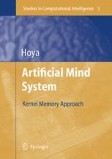Search
Search Results
-
Mathematical modelling of the Wnt-pathway
A kinetic model of the Wnt-signal transduction pathway is presented which includes the main molecular components of this system. It is based on a set...
-
Systems Biology: Did we know it all along?
It is often suggested that Systems Biology is nothing new, or that it is irrelevant. Its central paradigm, i.e. that much of biological function...
-
Systems biology of the yeast cell cycle engine
One goal of systems biology is to obtain an integrated understanding of the physiological properties of cells from the detailed molecular machinery...
-
A modular systems biology analysis of cell cycle entrance into S-phase
A modular systems biology approach to the study of the cell cycle of the budding yeast Saccharomyces cerevisiae is presented. Literature on the...
-
What is systems biology? From genes to function and back
The essence of the grand contributions of physiology and molecular biology to biology is discussed in relation to what may be needed to understand...
-
Modeling the E. coli cell: The need for computing, cooperation, and consortia
Escherichia coli K-12 is an ideal test bed for pushing forward the limits of our ability to understand cellular systems through computational...
-

-
Introduction
“What is mind?” When you are asked such a question, you may be probably confused, because you do not exactly know how to answer, though you...
-
The Self-Organising Kernel Memory (SOKM)
In the previous chapter, various topological representations in terms of the kernel memory concept have been discussed together with some...
-
Hybrid Computational Intelligence Systems for Real World Applications
This chapter covers two topics. An introduction into the field of the main disciplines used in computational intelligence and detailed description of...
-
Autonomous Mobile Robots – From Science Fiction to Reality
For hundreds of years, people have dreamt of automatons that assist them in simple as well as difficult tasks. The term “automaton” dates back as far...
-
Prototype Based Recognition of Splice Sites
Splice site recognition is an important subproblem of de novo gene finding, splice junctions constituting the boundary between coding and non-coding...
-
Artificial Neural Networks for Reducing the Dimensionality of Gene Expression Data
The use of gene chips and microarrays for measuring gene expression is becoming widespread and is producing enormous amounts of data. With increasing...
-
Computational Complexity of the XCS Classifier System
Learning classifier systems (LCSs) are online-generalizing rule-based learning systems that use evolutionary computation techniques to evolve an...
-
Conclusions
This chapter concludes this monograph. It starts with the summary of the progress, results, and status of the research project, followed by tasks of...
-
A First Improvement: Using Promoters
Harik [47] took Holland’s call [53] for evolution of tight genetic linkage and proposed the linkage learning genetic algorithm (LLGA), which used a...
-
Learning in the AMS Context
In this chapter, we dig further into the notion of “learning” within the AMS context. In conventional connectionist models, the term “learning” is...
-
Two Simple Learning Classifier Systems
Since its introduction Holland’s Learning Classifier System (LCS) [Holland, 1976] has inspired much research into ‘genetics-based’ machine learning...
-
A Mathematical Framework for Studying Learning in Classifier Systems
Massively parallel, rule-based systems offer both a practical and a theoretical tool for understanding systems that act usefully in complex...
-
What Makes a Problem Hard for XCS?
Two basic questions to ask about any learning system are: to what kinds of problems is it well suited? To what kinds of problems is it poorly suited?...
